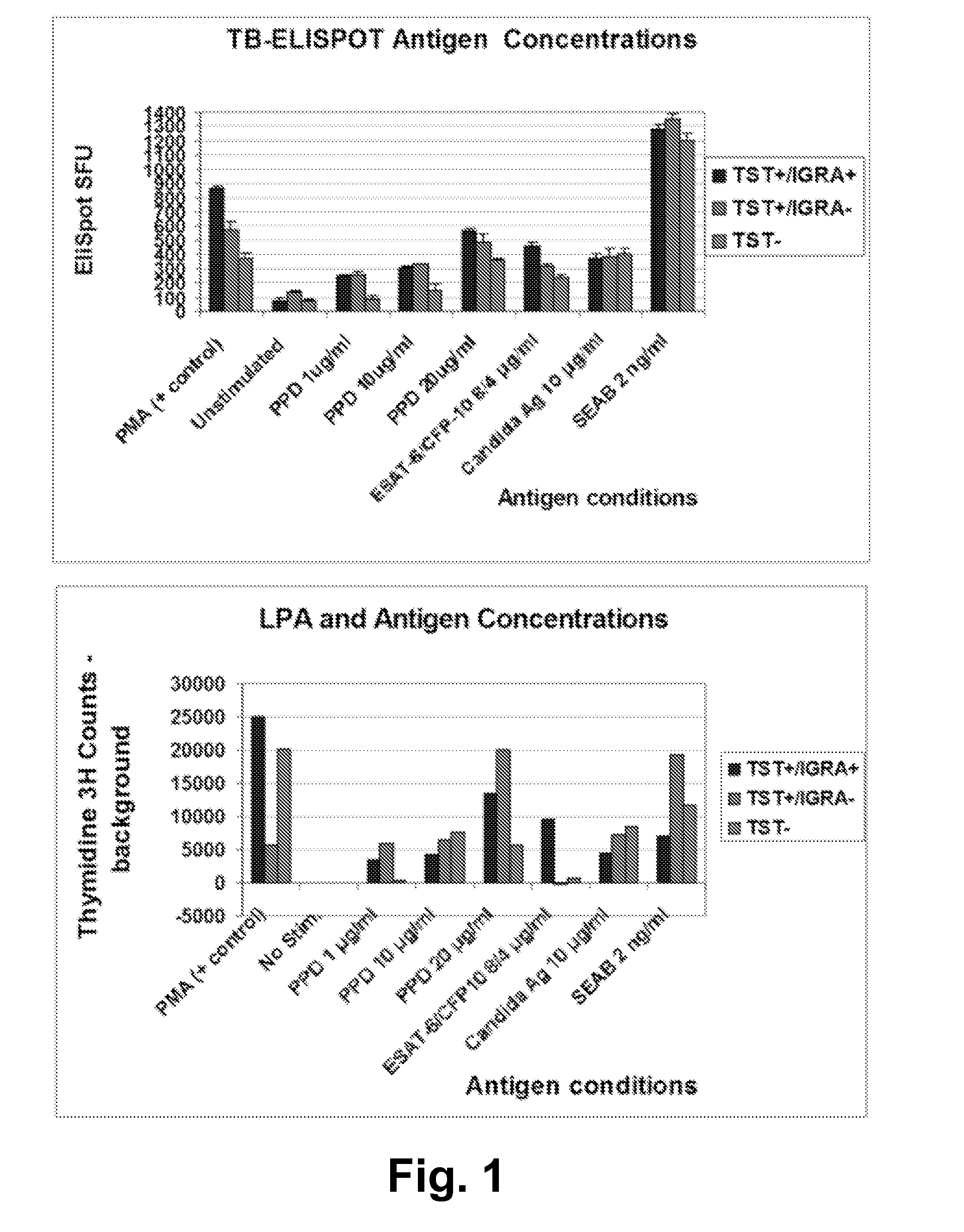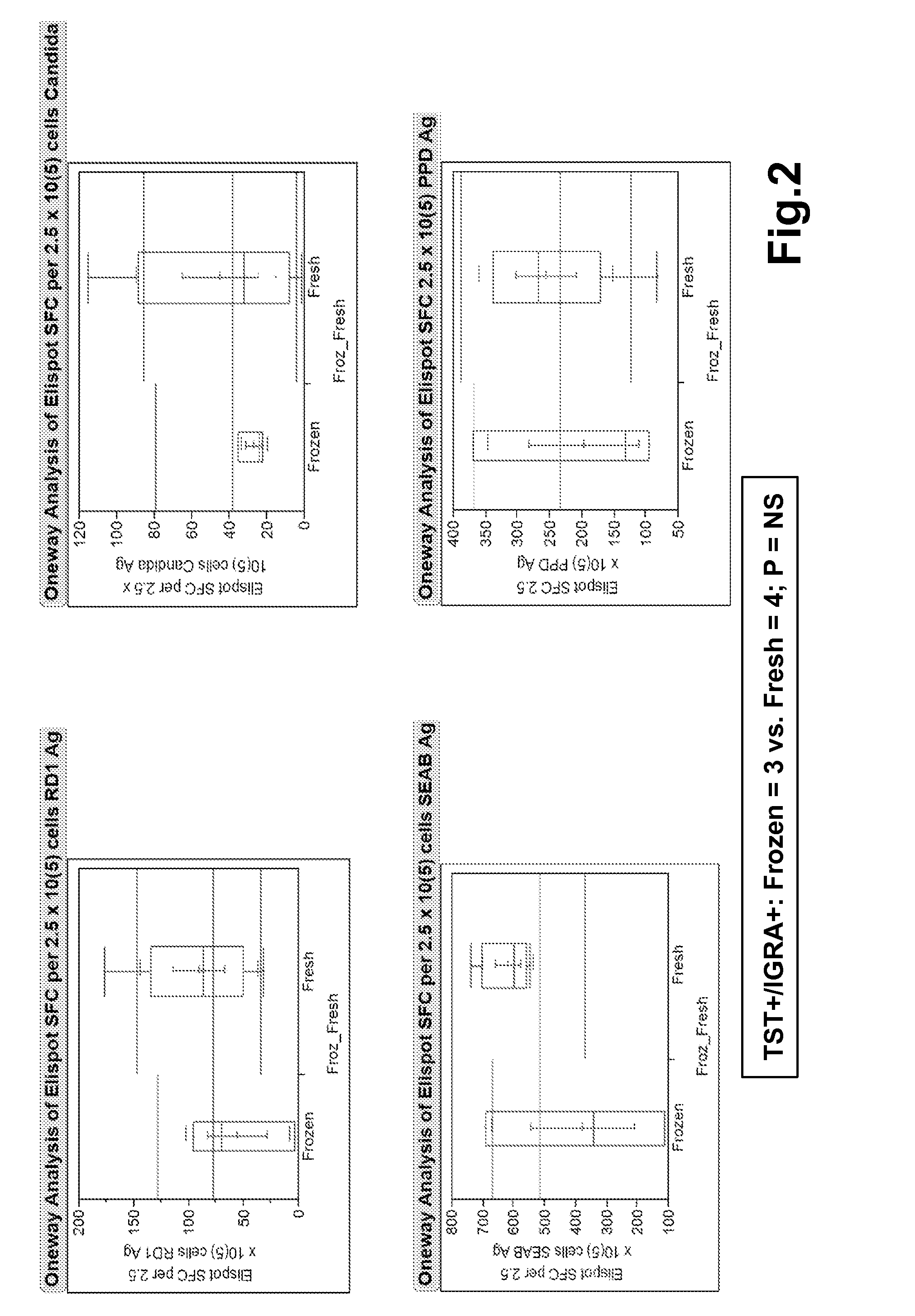Detecting latent tuberculosis infections
a technology of latent tuberculosis and detection methods, applied in the field of latent tuberculosis detection methods and materials, can solve the problems of difficult accurate detection of ltbi, undiagnosed ltbi patients can progress to active tb disease with potentially devastating consequences, and the interpretation of discordant testing (e.g., tuberculin skin tests (tst) and interferon-gamma release assays) can also be difficul
- Summary
- Abstract
- Description
- Claims
- Application Information
AI Technical Summary
Benefits of technology
Problems solved by technology
Method used
Image
Examples
example 1
An Enhanced ELISpot Interferon-Gamma Release Assay for Detecting Latent Tuberculosis Infection
[0056]This following ELISpot assay protocol was developed to detect LTBIs. The following eight steps are performed on day 1 of the assay.
[0057]1. Prepare cell culture media: Use a conical tube; add 50 mL RPMI 1640 (with 2 mM L-glutamine) supplemented with 10% human AB serum and 0.5 mL of Pen-Strep mixture (Gibco #15140-122) to final concentration of penicillin 100 IU / mL and streptomycin (100 μg / mL) in culture medium.
[0058]2. Within 2 hours of blood collection in heparinized tubes (total 20 cc), harvest peripheral blood monocytes (PBMC) using a density gradient centrifugation of whole blood (Ficoll-Plaque™ technique), wash cells two times with PBS and add cell culture media in a polypropylene sterile tube for a final concentration 2.5×106 PBMCs / mL.
[0059]3. Perform stimulation procedures with PBMC's using concentration of (a) Staphylococcus Enterotoxin A and B (SEAB) or other super antigen or...
example 2
Detecting Latent Tuberculosis Infection with an Enhanced ELISpot Interferon-Gamma Release Assay
[0080]The following was performed to test the diagnostic performance of the ELISpot interferon-γ release assay set forth in Example 1 (referred to as TB-ELISPOT) in subjects with low to high probability of LTBI. Briefly, PBMCs were incubated for 40 hours with specific TB antigens and controls, using co-stimulatory antibodies. Spot counts in subjects with low probability of LTBI (TST-negative and concurrent commercial IGRA-negative results) and highly likely LTBI cases were compared. The area under the curve(AUC) of ROC was analyzed, and the optimal cut off values that differentiate these populations were determined and applied to the selected test cases.
[0081]32 subjects were enrolled, including 17 normal subjects with TST-neg / IGRA-neg results, and highly likely LTBI cases (nine TST-pos / IGRA-pos, one TST conversion (TST-pos / IGRA-neg), and one old-healed TB case). TB-ELISPOT AUC of ROC for ...
example 3
Detecting Latent Tuberculosis Infection with an Enhanced ELISpot Interferon-Gamma Release Assay
[0084]The study set forth in Example 2 was expanded to include an additional 40 subjects for a total of 72. In addition, of the original 17 normal subjects with TST-neg / IGRA-neg results, six were classified as being probable for a prior TB exposure, and four were classified as being possible for a prior TB exposure. Thus, the data was reanalyzed and included only healthy subjects with unlikely prior TB exposures (10 subjects) as negative controls to more accurately study the diagnostic performance of the assay.
[0085]Briefly, PBMCs were incubated for 40 hours with specific TB antigens and controls, using co-stimulatory antibodies. Spot counts in subjects with low probability of LTBI (TST-negative and concurrent commercial IGRA-negative results) and highly likely LTBI cases were compared. The area under the curve (AUC) of ROC was analyzed, and the optimal cut off values that differentiate th...
PUM
 Login to View More
Login to View More Abstract
Description
Claims
Application Information
 Login to View More
Login to View More - R&D
- Intellectual Property
- Life Sciences
- Materials
- Tech Scout
- Unparalleled Data Quality
- Higher Quality Content
- 60% Fewer Hallucinations
Browse by: Latest US Patents, China's latest patents, Technical Efficacy Thesaurus, Application Domain, Technology Topic, Popular Technical Reports.
© 2025 PatSnap. All rights reserved.Legal|Privacy policy|Modern Slavery Act Transparency Statement|Sitemap|About US| Contact US: help@patsnap.com



